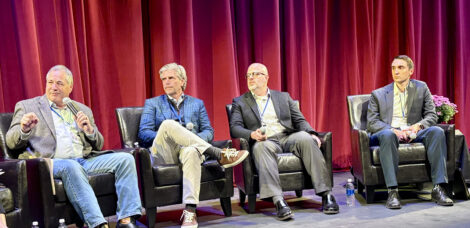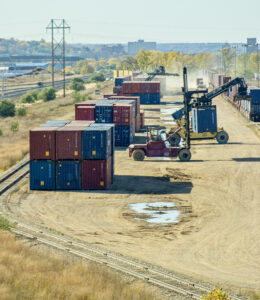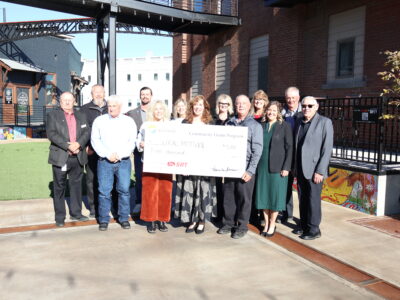Minot intermodal creates export opportunities
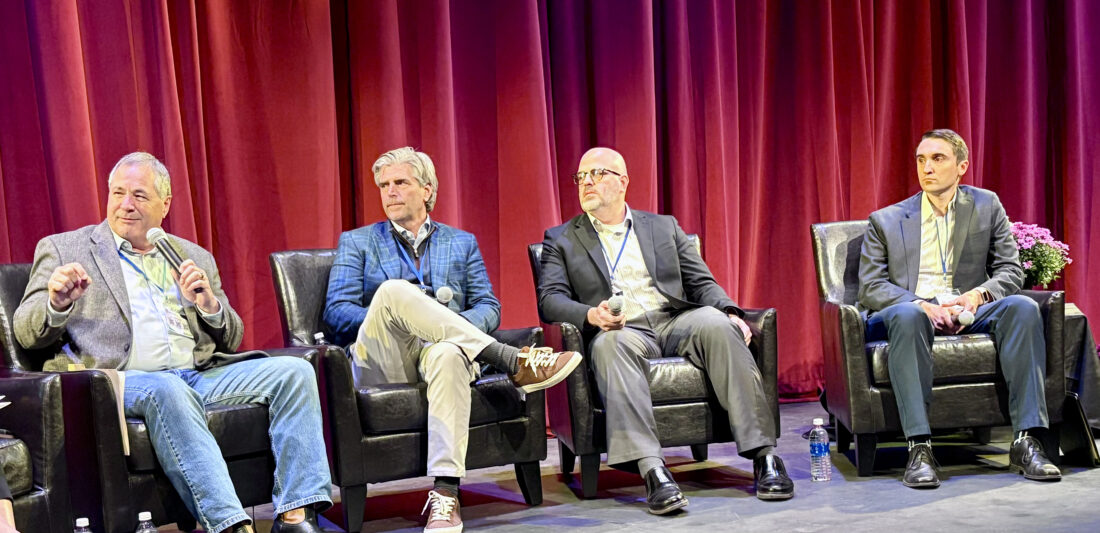
Jill Schramm/MDN Participating on a panel discussion on intermodal services during the Economic Development Association of North Dakota conference in Minot Tuesday, Oct. 7, are, from left, state Agriculture Commissioner Doug Goehring, Greg Oberting with Rail Modal Group, Ben Murray with BNSF Railway and Louis Terdan with the Northwest Seaport Alliance.
Rail Modal Group and its partners touted the success of the Minot Intermodal Facility on Tuesday, Oct. 7, during the Economic Development Association of North Dakota fall conference in Minot. Conference participants had a chance to tour the facility on Minot’s southeast side, which was in full swing with activity.
Greg Oberting, CEO of Rail Modal Group, said about 75 inbound trucks were expected Tuesday, carrying commodities to fill 85-90 rail containers destined for West Coast seaports. The facility, scheduled to load three intermodal trains over the course of this past week, was handling about a half dozen commodities on Tuesday.
The facility has been shipping soybeans, a commodity that’s been in a tough place since the decision of China to halt purchases in response to U.S. tariffs on its products. Farmers have struggled to find buyers willing to take their soybeans following the loss of that huge market.
“We can’t take all the soybeans that are produced in North Dakota, but at least we can help out with some local producers that need an outlet for soybeans. So, we’re receiving a little extra soybeans during harvest right now,” Oberting said.
He said Rail Modal Group’s soybean shipments to China have been small in the past due to a preference for working with other countries. Currently, soybeans are going to Taiwan, Vietnam, Malaysia and Thailand. Oberting said a trade mission to southeast Asia helped fill the intermodal facility’s recently expanded handling capacity.
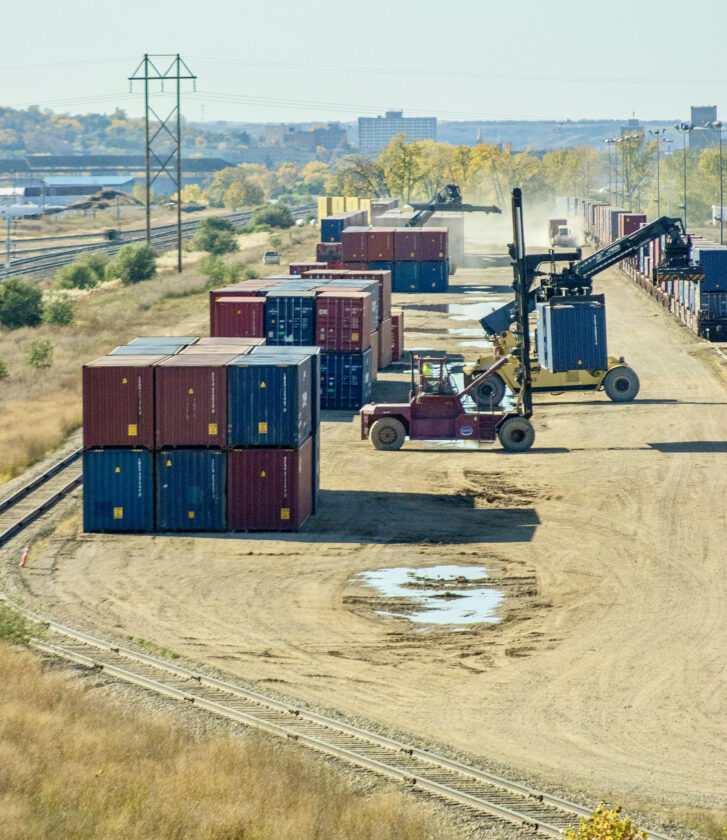
Submitted Photo Container movement takes place at the Minot Intermodal Facility Tuesday, Oct. 7. Empty containers are removed from inbound trains, filled with product and loaded onto outboard trains headed to coastal ports. Photo from Minot Area Chamber EDC.
Oberting said the intermodal site has been shipping distillers grains from the ethanol plant in Underwood and sugar beet pellets from two sugar processing plants for dairy feed in Korea and Japan. Different grades of wheat and other commodities also were being shipped this past week, he said.
North Dakota Agriculture Commissioner Doug Goehring, who participated in the intermodal panel discussion at the conference, said the state has exported commodities to more than 170 countries. In addition to commodities, the state’s ag manufacturers have equipment that’s sought after around the world, he said.
“Oddly, the limiting factor in all this is just knowledge – knowing what’s out there,” he said. The North Dakota Trade Office tracks data to determine potential markets and watches the political landscape to know which countries are best to do business with, he said. Trade missions add to that knowledge and allow existing relationships to connect to new market opportunities, he said.
Goehring encouraged in-state manufacturers looking for international markets to join a trade mission.
“There’s so much that exists out there, and especially in those developing countries. They want to grow. They want to do some things. We can potentially help that happen,” he said. “We’ve got an inland port right here we can send it through.”
The Minot Intermodal Facility, serviced by BNSF Railway, organizes containerization and shipment for regional exporters of various products and commodities, according to Minot Area Chamber EDC. The facility has won awards from the International Economic Development Council and the Economic Development Association of North Dakota.
The intermodal facility came to fruition following a feasibility study by Minot Area Development Corp., now MACEDC. The facility that began developing more than 15 years ago had its initial struggles, but the commitment of partners and the enlistment of Rail Modal Group as operator enabled the project to turn a major corner in 2020. Last October marked the 100th train since 2020 to leave the Minot Intermodal Facility, which at that time had shipped about 200,000 containers over the four years, MACEDC and Rail Modal Group reported.
“Overall, what it illustrates is the commitment that North Dakota has made, the value that’s been seen, the exporters, the food and agricultural community that got behind it,” Goehring said. “With all the great partnerships, it’s become a success, and I think it has a wonderful, bright future in the partnership that exists with Northwest Seaport Alliance. I think it takes us to that next level.”
Minot is the Northwest Seaport Alliance’s farthest inland reach.
Louis Terdan, business development manager for the Northwest Seaport Alliance, said Minot approached Northwest Seaport Alliance in 2018.
“This was our first successful launch of an inland hub,” said Terdan, who described the process as forming the blueprint for similar ventures. “We learned ‘what does a public-private partnership look like?’ ‘What do you need to focus on?’ We brought so much away from that initial experience.”
Terdan said the Minot region should be proud of what it has in the intermodal facility.
“We are extremely proud of it at the Northwest Seaport Alliance. We talk about it a lot. It’s on all of our marketing materials, our presentation materials,” he said. Overseas buyers know about Minot because the alliance talks about it on trade missions, he said.
Panelist Ben Murray, director of sales with BNSF Railway Consumer Products Team, mentioned upcoming railroad investments into its hub infrastructure that should make even more freight containers available to the Minot facility. More details will be coming related specifically to BNSF’s rail improvements in North Dakota, he said, but there’s going to be a lot more investment.
In talking about goals for the Minot facility, Oberting referenced Rail Modal Group’s operations at its Nebraska intermodal facility, where bagged commodities, frozen meats and other value-added products enter the shipping chain for overseas markets.
“What we want to do is build value back to the producer, value back to the processor, value back to the manufacturer that either exists today or will develop and build here. We’d like to attract manufacturing here. We’d like to develop and attract processing here,” Oberting said.
“Our vision is to be at the front end of that in developing the most efficient, economical and sustainable supply chain solution in partnership with these gentlemen,” he said of fellow panelists, “and everyone in North Dakota.”
- Jill Schramm/MDN Participating on a panel discussion on intermodal services during the Economic Development Association of North Dakota conference in Minot Tuesday, Oct. 7, are, from left, state Agriculture Commissioner Doug Goehring, Greg Oberting with Rail Modal Group, Ben Murray with BNSF Railway and Louis Terdan with the Northwest Seaport Alliance.
- Submitted Photo Container movement takes place at the Minot Intermodal Facility Tuesday, Oct. 7. Empty containers are removed from inbound trains, filled with product and loaded onto outboard trains headed to coastal ports. Photo from Minot Area Chamber EDC.

